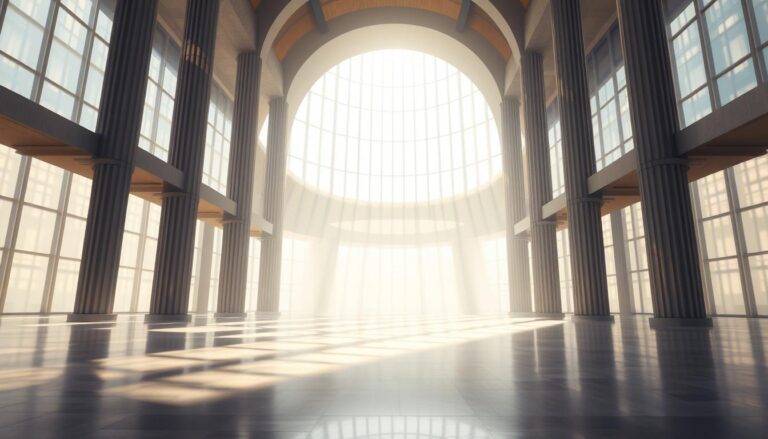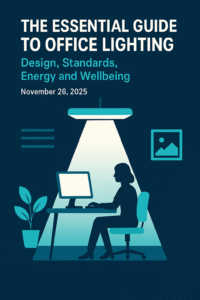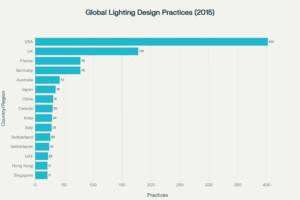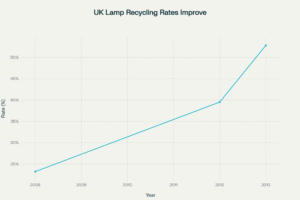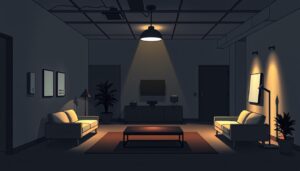What if the buildings around us weren’t just static objects, but living, breathing entities that change with the time of day? We often think of structures in terms of length, width, and height. But there’s a crucial element that brings them to life.
We’re exploring a concept that moves beyond traditional three-dimensional thinking. It introduces time as a fundamental component of design. This approach transforms our built environment from a passive backdrop into an active participant in our daily lives.
Light is the primary medium that makes this idea tangible. As sunlight moves across a space, it alters our perception and emotional response. A room feels different at dawn, midday, and dusk. This dynamic quality is what we mean by the fourth dimension.
This guide connects abstract theory to practical applications for facility managers and lighting consultants. We’ll show how designing with temporal shifts in mind creates more adaptable, human-centred, and sustainable solutions. It’s about crafting spaces that resonate with the rhythms of the world.
The Concept of the Fourth Dimension in Modern Architecture
The idea that our surroundings are not fixed, but constantly evolving, finds its roots in both scientific thought and mathematical principles. This perspective moves us beyond a static view of buildings.
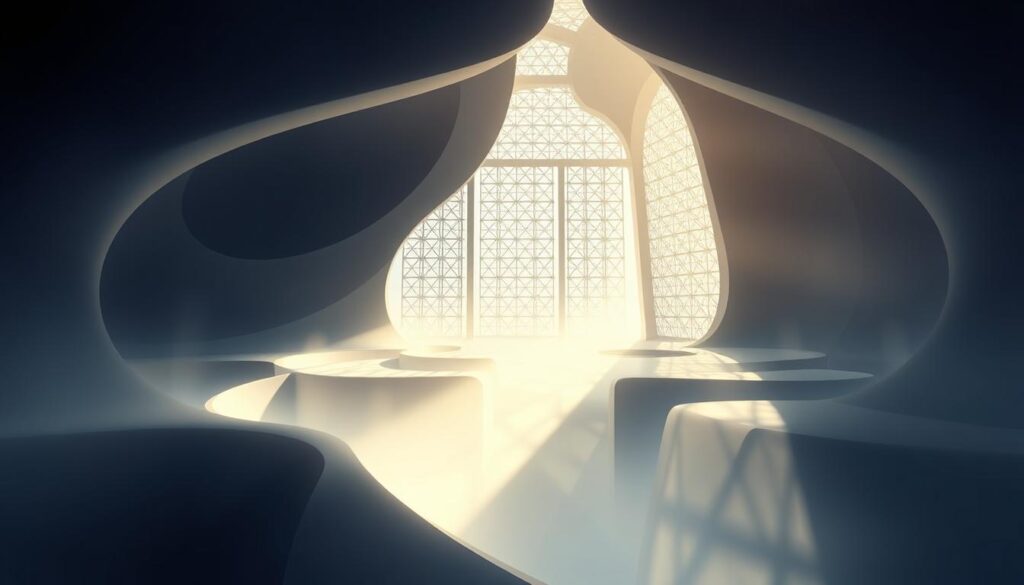
Defining the Fourth Dimension
The concept has solid foundations in science. Physicist Hermann Minkowski integrated time into spatial dimensions, creating the spacetime framework that Einstein later popularised.
Philosopher Henri Bergson emphasised “lived time” as essential to understanding human existence. This influences how we perceive time in our built environment.
Even in the 18th century, mathematicians D’Alembert and Lagrange proposed time as a fourth dimension. Lagrange introduced ‘t’ as a temporal coordinate. It represented the time dimension in a spacetime system, and is used in physics, especially relativity, to describe events in terms of their location in both space and time.
Architectural Implications and Vision
This is not abstract theory. For lighting professionals, it translates into a practical way of understanding how buildings must respond to change.
We design dynamic environments that actively participate in the flow of time. This affects material selection and lighting control systems.
Understanding these concepts provides the foundation for creating truly adaptive buildings. They serve occupants better across different times of day and seasons.
Comparing Design Approaches
| Design Principle | Static Three-Dimensional Approach | Dynamic Fourth-Dimensional Approach |
|---|---|---|
| Primary Focus | Fixed form and structure | Evolving experience over time |
| Lighting Strategy | Consistent, artificial illumination | Responsive, blending natural and artificial light |
| Occupant Experience | Uniform throughout the day | Varied, connecting with natural rhythms |
This represents a paradigm shift. It’s about crafting spaces that acknowledge change as part of their fundamental nature.
Illuminating Space: How Light Transforms Architectural Design
We harness light not just for visibility, but as the key ingredient for creating spaces that breathe and evolve with the day. It is the most powerful tool for making temporal changes visible and experiential.

Natural illumination constantly shifts. Morning light energises a room. Midday light reveals its true form. Evening light soothes and calms. This daily cycle fundamentally alters how occupants perceive and use a space.
Harnessing Natural Illumination
Thoughtful design embraces these rhythms. We carefully consider a building‘s orientation and seasonal variations. Strategic elements like skylights and light wells channel and modulate illumination.
This approach supports different activities at various times. It creates a richer, more adaptable spatial experience. For consultants, it means integrating natural and artificial strategies that work together across the entire day.
The benefits are tangible. We see reduced energy consumption and improved occupant wellbeing. This method crafts environments that feel genuinely connected to the natural world, a core goal of modern architecture.
Temporal Architecture: Integrating Time and Dynamic Design
The true potential of architectural design emerges when spaces learn to adapt to the rhythms of daily life. We’re moving beyond static layouts to create environments that respond intelligently to changing needs throughout the day.
This approach considers how a room can serve multiple purposes efficiently. The transformation happens through a thoughtful process that aligns with human activities.
Chronological Sequences in Space
We design spaces that unfold in a logical series of experiences. A conference room might transform from a collaborative morning setup to individual focus zones by midday.
This chronological approach considers how people use spaces at different times. The process creates fluid environments that serve evolving needs.
Time-Based Functions and Natural Light
Natural illumination plays a crucial role in temporal design. We optimise building orientation to capture sunlight at specific times of day.
Skylights and adjustable windows respond to solar angles throughout the day. This creates optimal lighting conditions for different activities across temporal dimensions.
The result is a space that feels genuinely connected to natural rhythms. This approach improves both functionality and occupant wellbeing through intelligent adaptation.
Exploring the Fourth Dimension of Architecture
To fully grasp how buildings interact with time, we must look beyond architecture itself. Our most powerful knowledge comes from connecting ideas across different fields.
This interdisciplinary approach reveals how temporal dimensions shape human experience within a space.
Interdisciplinary Perspectives on Space and Time
The artistic world offers key insights. The Cubist movement, for example, showed multiple viewpoints at once. This technique captures the passage of time in a single image.
It’s a powerful analogy for designing buildings that feel different throughout the day.
Philosophy also contributes greatly. Phenomenology focuses on how we experience places through our senses and emotions. It acknowledges that our perception of any space is inherently tied to time.
This knowledge is crucial for creating environments that resonate with people.
Finally, movements like Deconstructivism challenge stable forms. They create fragmented designs that reflect the fluid nature of time and space.
Each discipline provides a unique lens. Together, they form a holistic understanding of this dynamic aspect of design.
How Disciplines Inform Temporal Design
| Field of Study | Core Contribution | Practical Application in Lighting |
|---|---|---|
| Cubism (Art) | Simultaneous multiple perspectives | Lighting schemes that change character to support different activities in the same room. |
| Phenomenology (Philosophy) | Focus on sensory, emotional experience | Using light quality (colour temperature, intensity) to evoke specific moods at different times. |
| Deconstructivism (Architecture) | Embracing fragmentation and flux | Dynamic lighting that highlights shifting spatial relationships and creates a sense of movement. |
For lighting professionals, this broad knowledge base is invaluable. It moves us beyond technical specs to create illumination strategies that truly support how people live and work over time.
Historical Perspectives: From Minkowski to Le Corbusier
Historical thinkers have long grappled with how time influences our built environment. The journey spans over a century, connecting mathematical theory with practical design.
Early Theories and Experiments
In the 19th century, mathematician August Ferdinand Möbius illustrated dimensional concepts through crystal transformations. His thought experiment showed how objects could change form by moving through another dimension.
Ancient structures like Athens’ Tower of Winds used sundials to measure time. Built in the 1st century BCE, it responded to environmental changes throughout the day.
Architectural Polychromy and Colour Theory
Le Corbusier described his creative work as a journey into a “miraculous fourth dimension“. For over 40 years, he developed his visual thinking through daily artistic practice.
His Architectural Polychromy emerged from this work. The colour system creates spatial effects that alter our perception. Le Corbusier believed colour fundamentally changes how we experience space.
The Cobra Museum exhibition revealed his multidimensional approach across four themes. This demonstrated how he integrated temporal thinking into his architectural work.
For modern lighting professionals, this historical knowledge provides a solid foundation. We’re building on ideas that have evolved across disciplines for generations.
Cultural Reflections on Multidimensional Design
Our journey into the fourth dimension of design finds a surprising and influential guide in a 19th-century literary work. Edwin Abbott Abbott’s 1884 novella, Flatland, remains a cornerstone for understanding how we perceive reality.
It presents a two-dimensional world whose inhabitants cannot conceive of height. This serves as a powerful metaphor for our own limitations in visualising time as a spatial dimension.
Literary and Artistic Influences from Flatland Onwards
The story’s protagonist, a Square, has a revelation when a sphere passes through his planar world. It appears as a circle that changes size, demonstrating how higher-dimensional objects project into our reality.
This idea is an interesting concept. It shows that three-dimensional forms can be understood as projections of four-dimensional ones. For designers, this is a fundamental concept.
Abbott’s work also carried social commentary about rigid hierarchies and limited perception. It reminds us that our understanding is constrained by the dimensions we experience directly.
The Cubist movement in art took a similar approach a century later. Artists like Picasso aimed to show objects from multiple viewpoints at once, capturing temporal change in a static image.
For professionals, these cultural touchstones provide an accessible way to explain complex ideas. They help frame temporal design in familiar terms, making the concept more approachable for clients and stakeholders.
Mathematical Foundations and Geometric Innovations
Architects working with time-based elements need a solid mathematical framework to move beyond theoretical concepts. We find this foundation in the systematic progression from basic geometric forms to complex multidimensional objects.
The journey begins with a zero-dimensional point. Moving this point creates a one-dimensional line. When the line moves perpendicular to itself, it generates a two-dimensional square.
This logical progression continues as the square moves perpendicular to its plane, creating a three-dimensional cube. The pattern extends naturally to the next level.
Understanding Tesseracts and Hypercubes
The cube moving perpendicular to itself generates the four-dimensional hypercube, or tesseract. This isn’t mystical geometry but follows the same logical rules we use daily.
Ludwig Schläfli’s groundbreaking 1852 work extended Euler’s characteristic formula to higher dimensions. For a tesseract, the calculation shows predictable patterns: 16 vertices – 32 edges + 24 faces – 8 cube cells + 1 hypercube = 1.
William Stringham developed methods for representing these complex objects through three-dimensional projections. This makes higher-dimensional thinking accessible for architectural applications.
For lighting professionals, these mathematical principles provide precision when designing temporal elements into building structures. We can calculate and predict how spaces will evolve over time.
Geometric Progression Through Dimensions
| Dimension Level | Base Object | Movement Direction | Resulting Form |
|---|---|---|---|
| Zero | N/A | Stationary | Point |
| First | Point | Linear | Line |
| Second | Line | Perpendicular | Square |
| Third | Square | Perpendicular to plane | Cube |
| Fourth | Cube | Perpendicular to itself | Tesseract/Hypercube |
This mathematical rigour allows us to design architectural elements that exist both spatially and temporally. We create structures that change configuration predictably over time.
The Evolution of Architectural Practices in the Digital Age
Modern architectural practice has been revolutionised by computational tools that enable predictive modelling of building performance over time. We’ve moved from static blueprints to dynamic systems that account for temporal changes.
BIM, Computational Simulations, and Dynamic Structures
Building Information Modelling (BIM) provides architects with comprehensive knowledge about how structures will behave across different seasons. Computational simulations analyse how natural light interacts with materials throughout the day.
Real-world examples demonstrate this evolution. The Dynamic Tower in Dubai features rotating floors that optimise views and energy capture. The Lego House employs modular design for continuous adaptation.
Traditional vs Digital Architectural Approaches
| Aspect | Traditional Practice | Digital Evolution |
|---|---|---|
| Design Process | Static blueprints and drawings | Dynamic 3D modelling with temporal data |
| Material Selection | Based on static performance data | Analysed for aging and changing conditions |
| Building Performance | Post-construction evaluation | Pre-construction simulation across different times |
Smart Home Technology and Sustainable Adaptation
House Zero represents the cutting edge of responsive architecture. Sensors provide real-time information to optimise indoor conditions automatically. This creates buildings that adapt to occupant needs.
Bioclimatic design integrates living systems for self-regulation. The digital age has transformed how we approach sustainable building materials and structure optimisation.
Ethical and Practical Considerations in Temporal Design
Responsive architectural systems demand careful consideration of both practical constraints and ethical responsibilities. We face the reality that dynamic buildings require specialised knowledge across multiple disciplines.
Our practice must balance innovation with real-world functionality. Advanced engineering knowledge is essential for maintaining complex systems that change throughout the day.
Sustainability, Adaptiveness, and Regulatory Challenges
Privacy concerns emerge when buildings monitor occupancy patterns. Architects must ensure data protection while creating responsive environments.
The financial equation requires careful analysis. Initial costs are often higher, but long-term benefits like energy savings justify the investment over time.
Regulatory frameworks present another challenge. Existing building codes weren’t designed for adaptive structures, requiring architects to work within current systems while advocating for updates.
Comparing Design Implementation Challenges
| Consideration Area | Traditional Design Approach | Temporal Design Challenges |
|---|---|---|
| Technical Expertise | Standard construction knowledge | Advanced materials science and engineering |
| Regulatory Compliance | Established building codes | Navigating uncharted regulatory territory |
| User Experience | Static functionality | Balancing automation with user control |
Ethical considerations around accessibility are paramount. Adaptive designs should serve all users, reconfiguring to meet diverse needs at different times.
The collaborative process involves architects, engineers, and facility managers working together. This ensures systems function properly in practice, creating spaces that genuinely improve the human experience.
Conclusion
We stand at a pivotal moment where buildings can truly respond to the rhythms of human life. Our exploration shows that integrating time as a fundamental design principle transforms static structures into dynamic partners.
Light remains the essential medium for this transformation, shaping our experience of a space throughout the day. The concepts and tools we’ve discussed—from smart materials to AI—provide practical ways to implement this thinking today.
This approach is a natural part of creating sustainable, regenerative lighting solutions. It helps reduce waste and extend a building‘s lifespan. Looking ahead, this multidimensional view will become standard practice.
It enables us to create environments that are both responsive to modern needs and respectful of our shared history. This is the powerful potential of the fourth dimension of architecture.
FAQ
What exactly is the ‘fourth dimension’ in an architectural context?
In architecture, the fourth dimension refers to the element of time and its impact on a structure. It considers how a building or space is experienced, changes, and functions over different periods—from the daily cycle of natural light to the long-term evolution of its materials and use.
How does light function as a key part of temporal design?
A> Light is a dynamic tool that fundamentally alters our perception of space. By harnessing both natural and artificial illumination, architects can create environments that transform throughout the day and year, influencing mood, highlighting different architectural elements, and responding to human activity in real-time.
What role do smart materials and AI play in this process?
Advanced technologies are crucial for creating adaptive architecture. Smart materials can change their properties in response to environmental stimuli, while AI and machine learning enable systems to learn from occupant behaviour and adjust lighting, temperature, and spatial configurations automatically for optimal efficiency and comfort.
How does this theory relate to sustainability?
Designing with time in mind promotes sustainability. Buildings that adapt to their environment reduce energy consumption. Furthermore, a focus on long-term transformation and the use of durable, refurbishable materials aligns with circular economy principles, minimising waste over the structure’s entire lifecycle.
Are there historical examples of this design approach?
Yes, the concepts have deep roots. Thinkers like Minkowski explored spacetime, while architects like Le Corbusier experimented with architectural polychromy—using colour and light to manipulate spatial perception. These early works laid the groundwork for today’s dynamic, time-based design principles.
